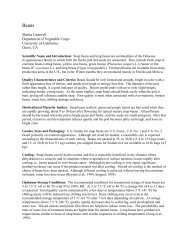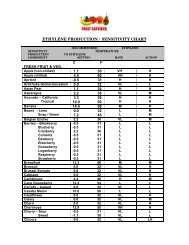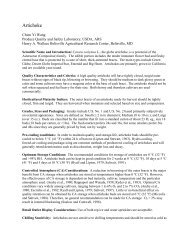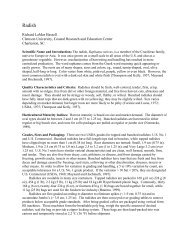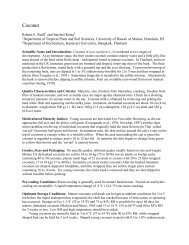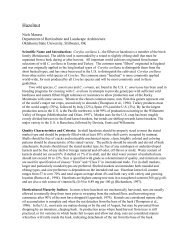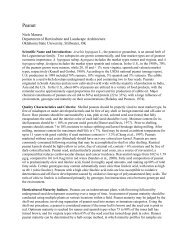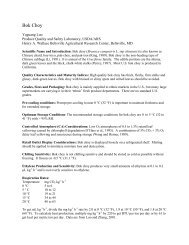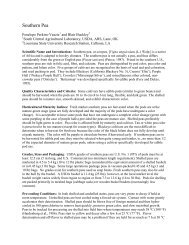Flower Bulbs
Flower Bulbs
Flower Bulbs
Create successful ePaper yourself
Turn your PDF publications into a flip-book with our unique Google optimized e-Paper software.
used because there are fewer negative effects of the long-term period of being “Frozen-in” (Van Aartrijk,2000). An alternative to this system is to produce the bulbs in the Southern Hemisphere for fall plantingin the Northern Hemisphere (Anonymous, 2001). “Planting stock” is stored at 2 ºC in moist peat untilplanted. De Hertogh (1996) has provided forcing guidelines for Asiatic and Oriental lilies in NorthAmerica.Narcissus (Hardy Daffodils and “Paperwhites”)General Aspects: There are two basic groups of Narcissus, the hardy Narcissus (daffodils) and the nonhardy“Paperwhite Narcissus.” Hanks (1993) has reviewed the physiology, pests, and other aspects ofthese groups. With the exception of the hot water treatment (see below), non-planted hardy Narcissusbulbs are never stored > 34 °C (see early forcing below), while “Paperwhites” are not stored > 30 °C(Hanks, 1993). Neither group of bulbs is stored < 0 °C (Van Aartrijk, 1995).Hardy Narcissus: By far, the largest group of Narcissus is comprised of the hardy cultivars and there arehundreds of grown in many countries. The major storage diseases are Fusarium and Penicillium (Bytherand Chastagner, 1993; Van Aartrijk, 1995). To control Fusarium in the “Planting stock”, approvedfungicides are added during a hot-water-treatment (HWT) of 1 to 2 h at 43.5 ºC. This treatment alsocontrols nematodes and bulb flies. Penicillium can be controlled by use of proper ventilation conditionsand a RH of 85 to 90%. Except for the HWT, “Planting Stock” bulbs are stored at 17 to 20 ºC.“Commercial <strong>Bulbs</strong>” for early forcing are given 1 week at 34 ºC followed by 17 ºC. All the other bulbsare provided 17 to 20 ºC. De Hertogh (1996) has provided forcing programs for hardy Narcissuscultivars in North America. Transportation of hardy daffodils either for forcing or garden and landscapeuse should be at 17 ºC under highly ventilated conditions.“Paperwhite” Narcissus: Most cultivars of “Paperwhite” Narcissus bulbs are produced in Israel. Theyare not considered to be hardy bulbs, but can be planted outdoors in USDA Climatic Zones 9 to 11(Cathey, 1991). “Planting Stock” and “Commercial <strong>Bulbs</strong>” are stored at 25 to 30 ºC after beingharvested. “Commercial <strong>Bulbs</strong>” should be shipped at 25 to 30 ºC under highly ventilated conditions.After arrival, bulbs should be stored at 25 to 30 ºC until shoots begin to emerge. Subsequently, theyshould be placed at 2 ºC. Prior to planting, they require 2 weeks at 9 to 17 ºC. De Hertogh (1996) hasprovided forcing programs for Israeli-grown “Paperwhite” Narcissus in North America.Tulipa (Tulips)General Aspects: Le Nard and De Hertogh (1993b) have reviewed the physiology, pests, and otheraspects of tulips. Without question, tulips are the largest taxa of flower bulbs grown and utilizedthroughout the world. Hundreds of cultivars are produced for forcing as fresh cut flowers, potted growingand plants, and for use in gardens and landscapes. The major storage diseases are Fusarium andPenicillium. Normally, Fusarium infections begin in the field and continue during postharvest storage.There are substantial differences in cultivar susceptibility, but it is important to reduce the number ofinfected bulbs in storage because of the ethylene they produce. This can lead to flower abortion andabnormalities. Thus, the bulbs must be routinely inspected and the rooms monitored for ethylene. Levelsin the storage rooms must not exceed 0.1 ppm. In storage, Penicillium can be controlled with high ratesof ventilation and RH of 85 to 90%. Regardless of the horticultural usage, tulip bulbs should be shippedat 17 ºC under a ventilation rate of 150 m 3 h -1 . With the exception of the 34 °C treatment for early forcing(see below), non-planted bulbs are never stored > 25 °C or < 0 °C (Le Nard and De Hertogh, 1993b; VanAartrijk, 2000).Planting Stock: After being harvested, bulbs are initially placed at 23 to 25 ºC for 3 to 4 weeks.Subsequently, depending on the cultivar, they are stored at progressively lower temperatures, ie., 23 to 20ºC to 17 to 15 ºC until just before being planted. These temperatures are used to encourage enhancedproduction of large sized bulbs from the “Planting Stock”.Forcing <strong>Bulbs</strong>: For very early forcing, most cultivars are given 34 °C for 1 week immediately afterlifting, subsequently; they are stored under dry and well-ventilated conditions at 17 to 20 °C.
Subsequently, it is very important to be able to identify the stages of flower initiation (Hartsema 1961),since most cultivars must reach “Stage G” prior to being pre-cooled at 5 to 9 ºC. For medium and lateforcing, bulbs are placed at 17 to 23 ºC prior to planting at low temperatures. De Hertogh (1996) hasprovided forcing programs for cut and potted tulips in North America. <strong>Bulbs</strong> can also be stored undermodified atmospheres (ULO) for Fall forcing (Anonymous, 1996b). However, bulbs are also grown inthe Southern Hemisphere for planting in the Fall in the Northern Hemisphere (Anonymous, 2001). Aswith the hybrid lilies, this eliminates the need and effects of long storage periods.Garden and Landscaping <strong>Bulbs</strong>: The key to utilization of tulip bulbs in North America is the USDAClimatic Zone (Cathey, 1990). In northern climatic zones, they naturally receive adequate cold exposureto satisfy their low temperature requirement. In warm climatic zones, they must be pre-cooled at 5 ºC for8 to 10 weeks prior to planting. Normally, after being harvested, tulip bulbs for gardens and landscapeusage are stored at 20 to 23 °C and then shipped and stored at 17 °C prior to being planted.Literature Cited:Anonymous. 1996a. Resultaten ULO-bewaring lelies hoopvol. CNB INFO 551:19.Anonymous. 1996b. Broeiseizoen ULO-tulpen bevredigend verlopen. CNB INFO Kerstnummer 23.Anonymous. 2000. Inventarisatie Wereldbollenareaal. Bloembollencultuur 21:4.Anonymous. 2001. Bollenareaal: Wereldwijde groei. Bloembollencultuur 21: 7; 17-19.Baker, J. 1993. Insects. In: The Physiology of <strong>Flower</strong> <strong>Bulbs</strong>. A. De Hertogh and M. Le Nard (eds)Elsevier Science Publishers, Amsterdam, The Netherlands, pp. 101-153.Beattie, D.J. and J.W. White. 1993. Lilium - Hybrids and Species. In: The Physiology of <strong>Flower</strong> <strong>Bulbs</strong>. A.De Hertogh and M. Le Nard (eds) Elsevier Science Publishers, Amsterdam, The Netherlands, pp.423-454.Byther, R. and G. Chastagner. 1993. Diseases. In: The Physiology of <strong>Flower</strong> <strong>Bulbs</strong>. A. De Hertogh andM. Le Nard (eds) Elsevier Science Publishers, Amsterdam, The Netherlands, pp. 71-79.Cathey, M. 1990. USDA Plant Hardiness Zone Map. USDAgriculture, ARS, Misc. Pub. No. 1475. U.S.Govt. Printing Office, Washington, D.C.Cohat, J. 1993. Gladiolus. In: The Physiology of <strong>Flower</strong> <strong>Bulbs</strong>. A. De Hertogh and M. Le Nard (eds)Elsevier Science Publishers, Amsterdam, The Netherlands, pp. 297-320.De Hertogh, A.A. 1996. Holland Bulb Forcer’s Guide. 5th edition, Intl. <strong>Flower</strong> Bulb Centre, Hillegom,The Netherlands.De Hertogh, A.A. and M. Le Nard. 1993a. The Physiology of <strong>Flower</strong> <strong>Bulbs</strong>, Elsevier Science Publishers,Amsterdam, The Netherlands.De Hertogh, A.A. and M. Le Nard. 1993b. Botanical aspects of flower bulbs. In: The Physiology of<strong>Flower</strong> <strong>Bulbs</strong>. A. De Hertogh and M. Le Nard (eds) Elsevier Science Publishers, Amsterdam, TheNetherlands, pp. 7-20.De Hertogh, A.A. and M. Le Nard. 1993c. World production and horticultural utilization of flower bulbs.In: The Physiology of <strong>Flower</strong> <strong>Bulbs</strong>. A. De Hertogh and M. Le Nard (eds) Elsevier SciencePublishers, Amsterdam, The Netherlands, pp. 21-28.De Hertogh, A.A. and M. Le Nard. 1993d. Physiological and biochemical aspects of flower bulbs. In: ThePhysiology of <strong>Flower</strong> <strong>Bulbs</strong>. A. De Hertogh and M. Le Nard (eds) Elsevier Science Publishers,Amsterdam, The Netherlands, pp. 53-69.De Hertogh, A.A. and M. Le Nard. 1993e. Physiological disorders. In: The Physiology of <strong>Flower</strong> <strong>Bulbs</strong>.A. De Hertogh and M. Le Nard (eds) Elsevier Science Publishers, Amsterdam, The Netherlands, pp.155-160.De Munk, W.J. and J. Schipper. 1993. Iris - Bulbous and Rhizomatous. In: The Physiology of <strong>Flower</strong><strong>Bulbs</strong>. A. De Hertogh and M. Le Nard (eds) Elsevier Science Publishers, Amsterdam, TheNetherlands, pp. 349-379.Hanks, G.R. 1993. Narcissus. In: The Physiology of <strong>Flower</strong> <strong>Bulbs</strong>. A. De Hertogh and M. Le Nard (eds)Elsevier Science Publishers, Amsterdam, The Netherlands, pp. 463-558.
Hartsema, A.M. 1961. Influence of temperatures on flower formation and flowering of bulbous andtuberous plants. In: Handbuch der Pflanzenphysiologie. W. Ruhland (ed) Springer Verlag, Berlin16:123-167.Le Nard, M. and A.A. De Hertogh. 1993a. Bulb growth and development. In: The Physiology of <strong>Flower</strong><strong>Bulbs</strong>. A. De Hertogh and M. Le Nard (eds) Elsevier Science Publishers, Amsterdam, TheNetherlands, pp. 29-43.Le Nard, M. and A.A. De Hertogh. 1993b. Tulipa. In: The Physiology of <strong>Flower</strong> <strong>Bulbs</strong>. A. De Hertoghand M. Le Nard (eds) Elsevier Science Publishers, Amsterdam, The Netherlands, pp. 617-682.Miller, W.B. 1993. Lilium longiflorum. In: The Physiology of <strong>Flower</strong> <strong>Bulbs</strong>. A. De Hertogh and M. LeNard (eds) Elsevier Science Publishers, Amsterdam, The Netherlands, pp. 391-422.Nowak, J. and R.M. Rudnicki. 1993. Hyacinthus. In: The Physiology of <strong>Flower</strong> <strong>Bulbs</strong>. A. De Hertoghand M. Le Nard (eds) Elsevier Science Publishers, Amsterdam, The Netherlands, pp. 335-347.Raunkiaer, C. 1934. Life Forms of Plants and Statistical Plant Geography. Clarendon Press, Oxford, UK.Stuart, N.W, S. Parsons and C.J. Gould. 1970. The influence of controlled atmospheres during coldstorage on the subsequent flowering of Easter lilies and bulbous Iris. HortScience 5:356.Theron K.I. and A.A. De Hertogh. 2001. Amaryllidaceae: geophytic growth, development and flowering.Hort. Rev. 25:1-70.Van Aartrijk, J. 1995. Ziekten en Afwijkingen bij Bolgewassen. Deel 2: Amaryllidaceae, Araceae,Begoniaceae, Cannaceae, Compositae Iridaceae, Oxalidaceae, Ranunculaceae. Tweede Druk.Laboratorium voor Bloembollenonderzoek, Informatie en Kennis Centrum Landbouw, Lisse, TheNetherlands.Van Aartrijk, J. 2000. Ziekten en Afwijkingen bij Bolgewassen. Deel l: Liliaceae. Derde Druk.Laboratorium voor Bloembollenonderzoek, Lisse, The Netherlands.
Table 1. Packing and storage temperature requirements of ornamental flower bulbs, Adapted from DeHertogh and Le Nard (1993c).Taxa Storage Requirements Packing Requirements Storage Temp (ºC)Achimenes Prevent from drying Peat 10 to 15Acidanthera Dry and ventilated None 20AlliumGiganteum Dry and ventilated None 25 to 28Other Alliums Dry and ventilated None 20 to 23Alstroemeria Prevent from drying Peat 1 to 3A. belladonna Prevent from drying Peat 13 to 23Anemoneblanda & fulgens Dry and ventilated None 9 to 17coronaria (Summer) Dry and ventilated None 15 to 25coronaria (Winter) Dry and ventilated None 10 to 13Anigozanthos Prevent from drying Not reported 2 to 20Begonia Prevent from drying Peat 2 to 5(Tuberous Hybrids)Caladium Dry and ventilated None 23 to 25Camassia Prevent from drying Wood shavings 17 to 20Canna Prevent from drying Peat 5 to 10Chionodoxa Prevent from drying Wood Shavings 20Clivia Prevent from drying Peat 13Colchicum Prevent from drying Wood shavings 17 to 23Convallaria Keep frozen-in Peat -2Crocosmia Prevent from drying Plastic 2 to 5Crocus Dry and ventilated None 17 to 20Cyclamen Prevent from drying Peat 9Dahlia Prevent from drying Peat 5 to 10Endymion Prevent from drying, Wood shavings 20(Scilla campanulata) store in paper bags.Eranthis Prevent from drying Peat 5Eremurus Prevent from drying Peat 5 to 7Erythronium Prevent from drying Peat 5 to 9Eucharis Prevent from drying Peat 20Eucomis Dry and ventilated None 13 to 20Freesia Dry and ventilated NonePre-Shipping 30Post-Shipping 9 to 13Fritillaria imperialis Prevent from drying Wood shavings 23 to 25and Persica Meleagris Peat 2 to 5Galanthus Prevent from drying Peat 17Galtonia Prevent from drying Wood shavings 17 to 20Gladiolus Dry and ventilated None 2 to 10Gloriosa Prevent from drying Peat 10 to 18Gloxinia Prevent from drying Peat 5 to 9Haemanthus Dry and ventilated None 10 to 15Hemerocallis Prevent from drying Peat 7 to 10Hippeastrum Prevent roots from drying Peat or wood shavings 2 to 13Hyacinthus Dry and ventilated None 17 to 20Hymenocallis Prevent from drying Peat 7 to 10Table 1 (continued)
Iris Dry and ventilated None 20 to 25Dutch Hybrids Dry and ventilated None 17English Hybrids Prevent from drying Peat 0 to 5Germanica Hybids Dry and ventilated None 20 to 23reticulata & danfordiaeIxia Dry and ventilated None 20 to 25at 65-70% RHIxiolirion Dry and ventilated None 20Lachenalia Dry Peat 9 to 25A. LeucojumAestivum Dry and ventilated None 20Vernum Dry and ventilated None 2 to 5Liatris Prevent from drying None 2 to -2A. LiliumLongiflorum Prevent from drying Peat 2 to 7Hybrids and species Prevent from drying Peat and polyethylene 2 to -2Lycoris Dry and ventilated None 13 to 17A. Montbretia Prevent from drying Plastic 2 to 5B. Muscari Dry and ventilated None 20C. NarcissusHardy cultivars Dry and ventilated None 17Paperwhites Dry and ventilated None 2 to 30NerinePrevent from dryingShort term storage Peat 17 to 21Long term storage Peat 5 to 9A. OrnithogalumDubium Dry and ventilated None 9 to 30Thyrsoides Prevent from drying Wood shavings 23 to 25umbellatum & nutans Prevent from drying Wood shavings 20OxalisAdenophylla Prevent from drying Wood shavings 17 to 20Deppei Dry and ventilated None 2 to 5Polianthes Dry and ventilated None 20Puschkinia Dry and ventilated Wood shavings 20 to 23RanunculusSummer Dry and ventilated None 17 to 20Winter Dry and ventilated None 10 to 13Scadoxus Dry and ventilated None 10 to 15Scilla siberica Dry and ventilated Wood shavings 20 to 23Sparaxis Dry and ventilated None 25Tigridia In closed boxes Peat 2 to 5Triteleia (Brodiaea) laxa Dry and ventilated None 17 to 20Tulipa Dry and ventilated None 17L. Zantedeschia Dry and ventilated Wood shavings 7 to 10LI. Zephyranthes Dry and ventilated Polystyrene 17 to 20
Table 2. Hardiness classifications for ornamental flower bulbs.Hardiness Classification Injured at temperatures below:Tender I 20 ºCTender II 10 ºCTender III 2 ºCSemi-Hardy -2 ºCHardy I -5 ºCHardy II -10 ºCHardy III -15 ºC



